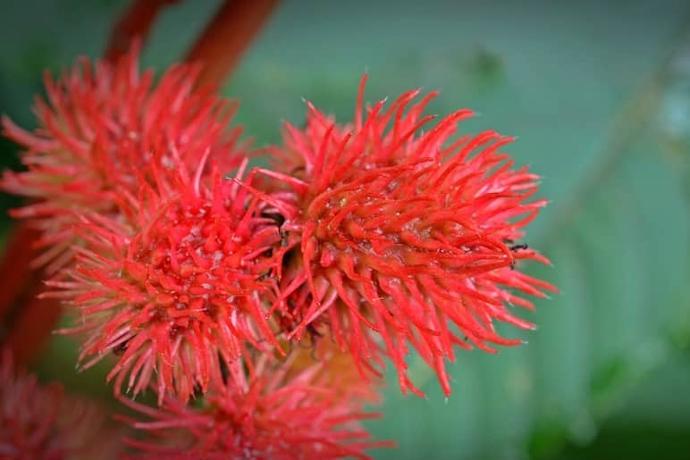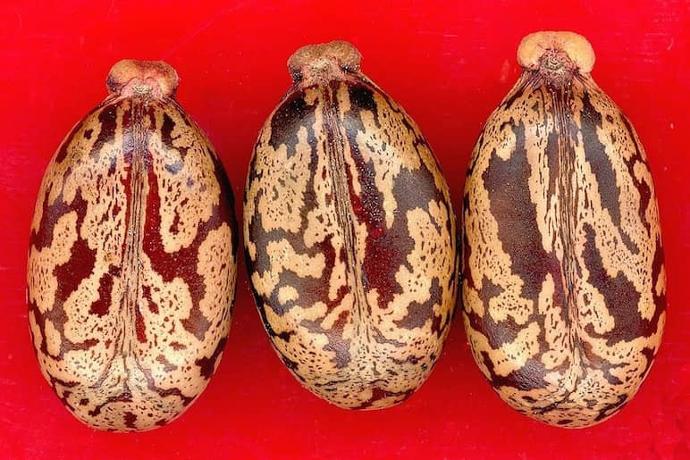Castor oil castor oil is a natural ingredient used since Antiquity for its exceptional exceptional cosmetic properties. Rich in fatty acids, it stimulates hair growth and deeply nourishes hair. Find out how to choose castor oil and, above all, how best to use it on your hair. hair.
What are the characteristics of castor oil?
Castor oil is derived from a tropical shrub - castor oil - and more specifically seeds contained in the fruits of this plant. This shrub in India, China and Brazil, although its origins lie in Africa. in Africa. Today, it is also grown in more temperate climates temperate climates, as well as in our own gardens.
Castor castor oil is characterized by its thick texture, clear color and discreet fragrance. It was used in ancient Egypt, more than 4000 years but also in India, in Ayurvedic medicine.
The castor oil seed is toxic due to the ricin it contains. It is filtered during the manufacturing process, and is therefore purified of its toxin, but is not edible. toxin, but it is not edible. It is, however, a remarkable in cosmetics.
Paying attention to a few specific indications on the bottle will allow you to choose quality castor oil. It must be extracted by first cold pressing of carefully selected seeds by master oil-makers who respect the traditional manufacturing process.

In fact, cold pressing releases the active ingredients of castor oil seeds while preserving the benefits of the liquid. The extraction process must not, of course, include the addition of chemicals, in order to preserve the minerals and fatty acids it contains. In this case, you should turn to pure castor oil, de préférence bio. Enfin, l’idéal pour choisir son huile de ricin is to opt for freshly pressed oil. All its nutrients are preserved, maximizing its effectiveness as a natural cosmetic treatment.
How to recognize a good castor oil?
To achieve this, it must be :
- Extracted by first cold pressing.
- 100% pure and natural, with no additives.
- Organic and made in France.
- Ideally, pressed to order.
What are the benefits of castor oil for hair?
Castor oil, also known as castor oil (which has nothing to do with animals), is used for its many cosmetic properties. Rich in fatty acids (Omega-3, Omega-6, Omega-9), it is a remarkable hair care product, especially for dry, frizzy, brittle and split ends, which it nourishes and repairs. But it is above all renowned for its action on hair growth.
Its main component, ricinoleic acid, stimulates prostaglandin production, thus acting as a catalyst for hair growth. Mixed with a small amount of light, non-greasy jojoba vegetable oil, it can also be used on oily and fine hair for its sebum-regulating action. Depending on needs, it can be applied to the scalp or ends, mixed with other plant oils or even essential oils. To optimize its effectiveness, it should be applied to dry hair.
Castor oil has many benefits for hairIt is used to stimulate hair growth and strengthen hair. Effective for hair growth, it also sheathes and nourishes hair. Recommended as a treatment for hair damaged by chemicals, blow-drying and coloring.
A genuine hair tonic, it is used on dull, devitalized hair to add volume and shine. It is also useful as a cure, over several weeks, for hair loss. Finally, it is appreciated for its similar virtues on eyelashes, eyebrows and beards. Castor oil can be used in the manufacture of numerous cosmetic products, such as hair care products, masks, shampoos and serums.
What does castor oil do for the hair?
- Makes hair softer and shinier.
- Promotes hair growth.
- Increases hair volume.
- Limits hair loss.
How to apply castor oil to your hair?
Castor oil is used directly on the scalp, for its stimulating and strengthening action; but also on the ends, to nourish them and make them shine. They can be used in a variety of ways, depending on the benefits sought: in oil baths, masks, protective serums or simply diluted in our cosmetics.
In fact, a few drops added to your bottle of shampoo or tube of mascara can be used to care for hair and eyelashes on a daily basis. A real plus for those who don't want to use it all over their head.
As a reminder is for external use only, and must not be ingested.
Castor oil, an effective hair care product
- Areas concerned: roots and tips.
- What does it do? The complete castor oil mask will deeply nourish dry hair, while stimulating micro-circulation to boost growth.
- Procedure: apply a generous amount of oil to the roots, massaging well into the scalp, then apply strand by strand to the lengths, paying particular attention to the ends.
- Recipe: 20 tablespoons castor oil.
- Application time: between 30 minutes and 1 hour, ideally with a self-heating cap to allow the mask to penetrate deep into the hair scales. You can also use a castor oil bath and leave on overnight. Shampoo twice if necessary.
- How often? 2 times a month.
How to combine castor oil and theJojoba oil ?
- Zones concerned: peaks
- For what effect? A light treatment for fine or oily hair will make hair shine, add shine or redefine curls, without weighing hair down.
- The gesture to adopt: mix castor oil with a non-penetrating vegetable oil, such asjojoba oilApply a dab to lengths and ends.
- Recipe: 50% castor oil + 50% non-penetrating oil, which coats the hair surface only.
- Application time: between 30 minutes and 1 hour, before shampooing; or by mixing a few drops directly into your shampoo bottle, for an express radiance boost. It can also be applied as a leave-in treatment, with a light hand on the amount of oil.
- How often: once a week.
What's the difference between castor oil and essential oil for hair?
- Zones concerned: scalp.
- For what effect? Apply with light, circular massaging movements to the scalp, castor oil blend and essential oil will stimulate hair bulbs and promote hair regrowth.
- The right thing to do: use castor oil as a base and combine with an essential oil renowned for stimulating hair growth, such as Bay Saint Thomas E.O., mustard or ylang-ylang.
- Recipe: 2 tablespoons castor oil + 4 drops Bay Saint Thomas essential oil.
- How often? 1-2 times a week for 3 weeks, with a 3-week break, and so on.
Nb: essential oils should be used with caution, especially by pregnant and breastfeeding women, and infants, for whom they are generally not recommended, but also by people with sensitive skin, asthmatics, epileptics or allergy sufferers.
Before using an essential oil, perform a test with 1 or 2 drops in the crease of the elbow and observe the area concerned after 24 hours to ensure that no reaction occurs.
How to boost hair growth with plant oils?
- Target area: scalp.
- To what effect? A cocktail of plant oils will promote hair growth and is an alternative for those who prefer not to use essential oils.
- The right thing to do: mix vegetable oils reputed to help hair grow and massage the scalp thoroughly (e.g.: -Spicea, -Spicea, -Spicea, -Spicea, -Spicea, -Spicea): avocado vegetable oils, coconut, oignon, jojobaetc.).
- Recipe: 1 teaspoon castor oil + 1 teaspoon ginger oil + 1 teaspoon neem oil + 2 teaspoons of olive oil. 1 tsp mustard oil.
- Application time: ideally, leave on overnight. You can wrap your hair in a warm towel for a few minutes to let it soak in, before protecting it overnight with a hair cap.
- How often? 1-2 times a week.
- Considered by some to be a miracle oil for hair growth, castor oil also has numerous benefits for the skin, helping to reduce wrinkles and fight acne.
Interested? Discover other articles sur hair en click here.




